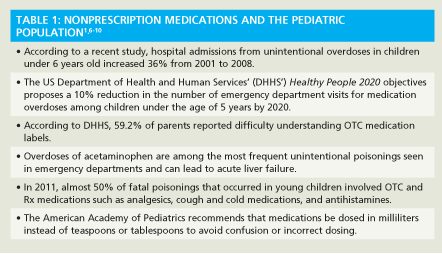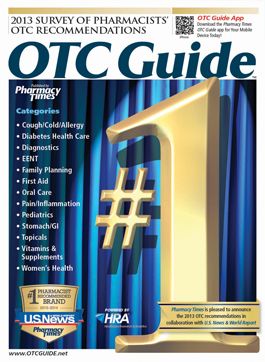Publication
Article
OTC Guide
Nonprescription Drugs and Pediatric Patients: Playing it Safe
Author(s):
According to a recent report from the Centers for Disease Control, annually an estimated 60,000 young children—approximately 165 children daily—are seen in emergency departments across the country after getting into medications.1,2 Pharmacists are in a pivotal position to increase awareness regarding the importance of safe medication use and storage of medications. Differences in physiology and pharmacokinetics, lack of sufficient clinical data within the pediatric patient population, insufficient drug labeling, and problems related to proper dosage and administration may pose various challenges in providing pharmaceutical care to pediatric patients.3
Examples of potential drug therapy issues that may arise when considering drug therapy among children include unnecessary drug use, inaccurate dosing, and improper administration and dosage form.3 While the safe use of all medications, including nonprescription drugs, is important for all patients, here we will focus on the efforts being made to provide safe and effective use of nonprescription drugs in the pediatric patient population.

Health care organizations such as the FDA, the Consumer Healthcare Products Association (CHPA), the Centers for Disease Control and Prevention (CDC), American Academy of Pediatrics, American Pharmacists Association, and American Medical Association, to name a few, have launched educational programs to increase awareness about medication safety and reduce dosing errors and adverse effects, especially among the pediatric population. A variety of useful educational resources are available for health care professionals, parents, and caregivers. The CDC has launched a new educational program called Up and Away and Out of Sight, which promotes education and awareness regarding medication safety for children.1
Top OTC Products
A host of nonprescription medications are formulated and marketed for the pediatric patient population in various therapeutic categories. The top-selling pediatric OTC products include analgesics/antipyretics, cough/cold medications, allergy medications, and gastrointestinal medications.3 For many of the available OTC products, the FDA recommends against the use of these products in children less than 2 years of age and also recommends that the use of cough and cold medications should not be used in those less than 4 years of age.3-5
In an effort to decrease the incidence of the inaccurate dosing measures, in May 2011, the FDA issued guidelines for liquid nonprescription medications that include any form of dispensing device, such as liquid analgesics and cough and cold products.1 The main points of these guidelines are3,5:
- A dosing device calibrated to the recommended dose should be included in all orally ingested liquid OTC medications
- Devices should be marked clearly with calibrated units of liquid measurement
- Manufacturers should ensure that dosage delivery devices are used only with the products they are packaged with
- The marking on the device should remain visible and not obscured even when the liquid is in the device.
In addition, in May 2011, the CHPA announced that its member companies were voluntarily converting single- entity APAP OTC liquid preparations to only 1 concentration of 160 mL/5 mL for all patients less than 12 years of age, and the concentrated infant drops were phased out in mid-2011 as well.3,9
According to results from the 2011 Annual Report of the American Association of the Poison Control Centers’ National Poison Data System, some of the top OTC products involved in exposure calls for children aged 5years and under to centers include10,11:
- Analgesics
- Topical diaper rash products
- Children’s vitamins with or without iron
- Antihistamines, excluding cough and cold preparations
- Calcium and calcium salts
- Diphenhydramine
- Laxative
- Homeopathic agents
Increasing Safety Awareness
Since pharmacists are one of the most accessible health care professionals, they can be instrumental in ensuring that parents/caregivers select and administer nonprescription products correctly to pediatric patients.3 Prior to recommending any products, pharmacists should always screen for potential drug/drug interactions and contraindications. When counseling patients about nonprescription pediatric products, pharmacists should always ensure that the parent/caregiver clearly understands both the dosing and administration instructions, as well as provide them with various non-pharmacologic measures that may help with various ailments.
With the help of the pharmacist, parents/caregivers should always be aware of potential adverse effects. They should be reminded to always consult their pediatricians when in doubt about dosing and the appropriateness of using an OTC agent as well as to always read the product label prior to administering any drug to a child. Parents of children under the age of 2 years should always consult their pediatrician for treatment options.
The National Council on Patient Information and Education website and the FDA website provide a series of tips that parents/caregivers can use when selecting and using nonprescription drugs for children. These tips include12-14:
- Always consult your health care provider first when in doubt about medication and/or dosing, to avoid medication errors.
- Always read and adhere to dosing, dosing intervals, and warnings given on the Drug Facts label on OTC medicine. Read the label each time the medicine is administered.
- Know the active ingredients in the medicine.
- Always know your child’s current weight so the proper dose can be administered.
- Adhere to all directions on the product label and check the dosage and concentration of products prior to administration.
- Always use the calibrated dosing device that is packaged with the selected medication to ensure proper dosing.
- If using multiple OTC products, always read the labels to check for therapeutic duplications or unnecessary drug use.
- Check the active ingredients of all medications prior to administration.
- Only give medications to your children that are specifically manufactured for children and only use medicine that treats your child’s specific symptoms.
- Only use OTC medications for the recommended duration unless otherwise directed by your primary health care provider and seek medical care if symptoms show signs of worsening or not getting better.
- Store medications in safe places and keep all medication out of the reach of children to avoid a poisoning emergency. Teach children about medication safety.
- In case of emergencies, always have the number to the Poison Control Center available (1-800-222-1222).
References
1. Centers for Disease Control and Prevention. Put your medicines up and away and out of sight. Centers for Disease Control and Prevention website. www.cdc.gov/features/medicationstorage.
2. Safe storage, safe dosing, safe kids: a report to the nation on safe medication. Safe Kids Worldwide website. www.safekids.org/assets/docs/safety-basics/safety-tips-by-risk-area/medicine-safety-study-2012.pdf.
3. Lawrence B, Isetts B. Patient assessment and consultation. In: Krinsky D, Berardi R, Ferreri S, et al, eds. Handbook of Nonprescription Drugs. 17th ed. Washington, DC: American Pharmacists Association; 2012
4. Children’s OTC cough and cold medicines. Consumer Healthcare Products Association website. www.chpa-info.org/issues/Childrens_CC_Overview.aspx.
5. FDA issues final guidance for liquid OTC drug products with dispensing devices [press release]. FDA website. www.fda.gov/NewsEvents/Newsroom/PressAnnouncements/ucm254029.htm.
6. Budnitz DS, Salis S. Preventing medication overdoses in young children: an opportunity for harm elimination. Pediatrics. 2011;127(6):e1597-e1599.
7. Bond GR, Woodward RW, Ho M. The growing impact of pediatric pharmaceutical poisoning. J Pediatr. 2011;160(2):265-270.
8. Yin SH, Johnson M, Mendelsohn AL, Abrams MA, Sanders LM, Dreyer BP. The health literacy of parents in the United States: a nationally representative study. Pediatrics. 2009;124(3):S289-S298.
9. No more infant dose of OTC APAP. MedPage Today website. www.medpagetoday.com/Pediatrics/GeneralPediatrics/26297.
10. Bronstein AC, Spyker DA, Cantilena LR Jr, Rumack BH, Dart RC. 2011 Annual Report of the American Association of Poison Control Centers' National Poison Data System (NPDS): 29th Annual Report. Clin Toxicol (Phila). 2012;50(10):911-1164.
11. An in-depth look at keeping young children safe around medicine. Safe Kids Worldwide website. www.ncdoi.com/OSFM/SafeKids/Documents/2013-medication-safety-report.pdf. Published March 2013.
12. Ten tips for parents. BeMedWise website. www.bemedwise.org/ten_ways/top_tips_parents.htm. Accessed January 3, 2010.
13. Giving medication to children. FDA website. www.fda.gov/ForConsumers/ConsumerUpdates/ucm164427.htm. Accessed January 4, 2011.
14. Using OTC drugs in children. OTCsafety.org website. http://otcsafety.org/en/medicine-safety/giving-medicine-to-children/.
About the Author
Ms. Terrie is a clinical pharmacy writer based in Haymarket, Virginia.







